
IRIS login | Reed College home Volume 94, No. 4: December 2015
Apocrypha: Traditions, Myths, & Legends
A Bomb in the Basement
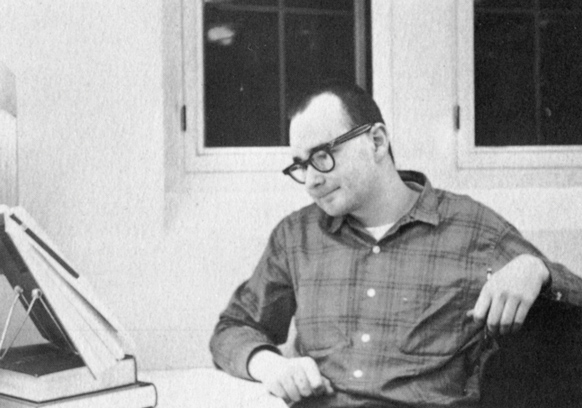
Philosophy major Dick Roistacher ’65
By Richard C. Roistacher ’65
It was such a very little bomb. Surely not a bomb large enough to worry about. At least, not immediately. In fact, it was hardly even a bomb at all. But enough of a bomb to get a bang and, from the dean, a whimper.
In May 1961, I was finishing the first of my two junior years at Reed. One of the things I did to quiet my anxieties (which were many) while not studying (which was often), was to shoot a pistol on the range under the Old Gym [located roughly where Kaul Auditorium now stands, demolished in 1965—Ed]. The range, which seems to have begun life as a crawl space, was too damp and insecure to store weapons and ammunition. The Reed College Rifle Club therefore maintained a set of lockers in the basement of Ladd House, a women’s dorm close to the range. The lockers were little square things; the sort of lockers you got in junior high school gym classes, where they didn’t care if your clothes got mashed. Each locker we secured by a cheap warded lock, the kind opened with a sheet metal key with notches cut into it. (Remember this detail; it will be useful later.)
One afternoon in May, I went to Ladd for a pistol and some ammunition. I had temporary custody of a ring of keys to all the lockers. While searching for some cleaning solvent, I looked in a previously opened locker. There, behind a heap of cleaning patches, was a small bottle bearing a plain paper label on which was written “PbN3.” If the label were to be believed, the several ounces of grey-brown stuff in it was lead azide—a primary explosive.
And now, gentle reader, a digression. A primary explosive is one used in primers. It detonates when struck or, perhaps, when heated. Primary explosives are useful, but not popular. Alfred Nobel got rich turning the primary nitroglycerin into the safer dynamite.
I knew all of this at the time because, while my first home was Reed, my second home was Detachment 3, Company A, 17th Special Forces Group (Airborne), U.S. Army Reserve. I was a gung-ho reservist, having joined the army after dropping out at the end of my freshman year. I had been trained, and worked on reserve weekends, as a demolitionist; making loud noises; polluting the air; cutting four-by-four timbers, railroad tracks, and girders; and teaching others to do the same.
I opened the jar, saw that it was about half full of whatever it was full of, put it back, and went off to shoot my pistol. Since I am somewhat absent minded and it was, after all, a very little bomb, I forgot all about it for the remainder of the summer.
I returned to campus in late August. About a week before the beginning of classes, I remembered the jar in the locker in the basement of the dorm. It really was time to get rid of the thing. Unfortunately, I had given my ring of keys back to Lee Bull ’62, the president and éminence grise of the rifle club. Lee was in parts unknown, probably in the national rifle matches in Ohio.
In those days, when faced with an otherwise insurmountable problem, one went to see Ann Shepard ’23 [dean of students 1926–68]. A tall, thin spinster with an angular New England face, Dean Shepard had listened sympathetically to countless hours of student anguish and looniness, including several hours of mine. I was therefore surprised when my innocent account of a bottle of high explosive in the basement of one of her dormitories discomfited her so much that she immediately called the police.
Very soon Officer Q.P. Humpelmeyer arrived, accompanied by two reporters from the Oregonian, who attached themselves like barnacles to chairs in Dean Shepard’s office.
Officer Humpelmeyer had on his sleeve a patch in the shape of an aerial bomb, on which were the initials “EORA.” I assumed that the patch meant that Officer Humpelmeyer was an EOD, an explosive ordinance disposal specialist, a grandmaster in the league of those who deal with explosives. An EOD is a graduate of a yearlong course that qualifies him or her to go down into a 30-foot hole to unscrew booby-trapped fuses from a World War II bomb, or defuse a World War III nuke. I later found out that EORA stood for “explosive ordinance reconnaissance agent,” which meant that he had taken a one-day course in what a bomb looks like.
Officer Humpelmeyer’s first question was, “What’s lead azide?” I was too busy trying to impress him with my knowledge and general explosive expert’s savoir faire to catch the hint of ignorance. It is not always true that knowledge conquers ignorance. Sufficiently large and vigorous ignorance can grab a tiny scrap of knowledge, skin it, and wear it like a coonskin cap.
I told him (and the reporters) that lead azide is a primary explosive, with a six-inch drop test. Now all of us real explosives experts know that a Picatinny drop test is done in a machine that drops a one-pound steel hammer on a small cup of explosive. An explosive with a six-inch drop test could probably be dropped several feet without danger of detonation. Such a small and tender piece of knowledge was instantly caught and skinned. The evening’s readers of the Oregonian learned that a mere six-inch jostle would set off what was now “the Reed College bomb.”
Since no keys were available, the police bomb expert was joined by the police lock expert. While the bomb expert was underqualified, the lock expert was overqualified. He had the equipment to pick all sorts of expensive cylinder locks, but nothing to pick a cheap warded lock. An afternoon of tweaking and twiddling went by without any success at opening the locker. Since everyone knew that the bomb was but six inches from doomsday, there was no question of drilling through the lock.
Finally, Orval Agee [1929–72], the head of Reed’s maintenance department, who had been watching for some time, spoke up to ask if anyone was interested in using his master key. They were; they did, and in seconds, the locker was open. (In the Reed of bricks, pipes, shrubs, and locks, Orval was sovereign.)
Now that the devilish device was exposed, what was to be done? Parked in front of the dorm were several police cruisers, an army jeep from Vancouver Barracks bearing the red fenders designating an EOD vehicle, and a battered Chevrolet station wagon belonging to Bill Ellston, my special forces buddy and qualified EOD specialist. The owners of this stationary car chase lounged around the basement, discussing who would do what. After a brief conference, the police and the army bomb squad agreed that Bill and I were perfectly qualified to dispose of the jar. Dean Shepard, who did not share this opinion, sent Prof. John Hancock [chemistry 1955–89] with us to maintain order and shield us from the press.
Prof. Hancock was a Reed legend. A character out of Masterpiece Theatre, he combined Mr. Chips with John Cleese. He was my mentor and friend during all my time at Reed, even though I dropped the one course I took from him with an F. He was a tall, angular man, with a reputation for being unflappable. That reputation was somewhat scored by the explosion of the Reed College bomb.
The four of us, Bill, John, myself, and the jar of lead azide, set off for our secret destination. Bill’s father had a farm outside the city, and on it we reservists kept a magazine of explosives. The army issued explosives only in 50-pound cases, and only after extensive bureaucratic purification rites. Since my unit never used a full case at one time, and liked to operate in a somewhat less formal fashion, we, quite against regulations, had our own stash. Our plan was to take the jar to the farm, prime it with a single blasting cap, and get rid of it.
“I’m glad you didn’t try to open that jar last spring,” Bill said to me, as we bounced along a dirt road.
“Why not?” I asked.
“Because old lead azide can form crystals. If there are crystals in the threads of the cap, opening the jar can leave you blind and fingerless.”
“Oh,” I said tonelessly. I decided not to mention that I had opened the jar.
We arrived at the farm to find a TV news crew with its camera already set up. As the camera rolled, Prof. Hancock delivered a lecture on the chemistry of lead azide, while courageously holding the deadly bottle in his very hand. In the background, Bill pried open a case of C-4 plastic explosive. I tried to look nonchalant while crimping a detonator and fuse lighter onto a time fuse that draped around my neck like a python around a carnival snake charmer.
Our original plan of detonating the jar with a single cap was abandoned in our media-inspired frenzy. We placed the bottle next to a stump and I primed a half-pound block of TNT to place next to it. Then Bill added five pounds of C-4 to the heap, and I added another pound of TNT that I found in my pocket. The newsies asked if we could put some dirt on the mess; we did. They asked if perhaps we could use something more interesting than a stump as a demolition site, perhaps that little structure over there. Bill observed that his father would not appreciate it if we blew up his hayrick.
I had measured three minutes’ worth of time fuse. Since I had primed the charge, it was my duty to fire it. Everyone else took cover several hundred feet from the stump. I checked the charge, the fuse, and the fuse lighter, a plastic gadget with a pull ring. The rule is that if you prime a charge that does not explode, then you must investigate and clear the misfire. The rule generally ensures careful work. I pulled the pin from the lighter, heard it pop, checked to see that the fuse was burning, and walked slowly back to colleagues and camera. Never run from a charge; you can trip, hurt yourself, or tear things up.
I got it right. We saw the results on the evening news, where the Reed College bomb was the lead local story. There was a shot of the police and the army waiting outside Ladd. Then the film cut to John, bottle in hand, lecturing deadpan into the camera. Behind him, we Corsican pirates prepared our deadly wares, trying not to gape into the camera. Finally came the static scene of a field, empty but for the stump, while on the sound track, John’s clipped, British voice counted down, “Five, four, three, two, one . . . any time now . . . .” Then it happened.
Had the charge consisted of a blasting cap and a bottle containing sand, “it” would have been a pop and a puff of dust. Had the bottle contained lead azide, “it” would have been a bang and a cloud of dust. But through the miracle of television, “it” consisted of a bright orange flash, a deafening boom, and a 100-foot flume of black smoke and dust. Thus was the world shown what would have happened in the basement of Ladd House had the bottle dropped the deadly six inches. The dean was not amused. We were.
Dean Shepard and John Hancock are dead now. I have not seen Bill Ellston in 26 years, and Officer Humpelmeyer’s fate is unknown to me. I was told who put the bottle in the locker, but it is for that person to say so. It all happened, and I am sure that it all happened exactly as I remember. Who else is left to say otherwise?
Editor's Note:
We are sad to report that Dick Roistacher ’65 died in June (see In Memoriam). After learning of his demise, we stumbled upon this piece in the archives. It was written in 1989, shortly after the death of Prof. Hancock.
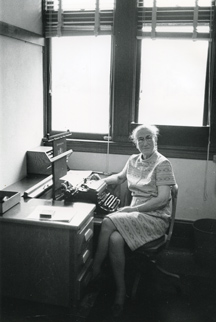
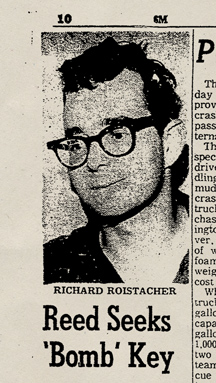
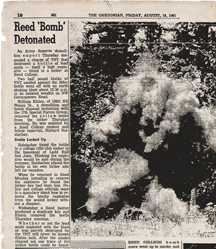
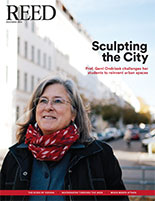
LATEST COMMENTS
steve-jobs-1976 I knew Steve Jobs when he was on the second floor of Quincy. (Fall...
Utnapishtim - 2 weeks ago
Prof. Mason Drukman [political science 1964–70] This is gold, pure gold. God bless, Prof. Drukman.
puredog - 1 month ago
virginia-davis-1965 Such a good friend & compatriot in the day of Satyricon...
czarchasm - 4 months ago
John Peara Baba 1990 John died of a broken heart from losing his mom and then his...
kodachrome - 7 months ago
Carol Sawyer 1962 Who wrote this obit? I'm writing something about Carol Sawyer...
MsLaurie Pepper - 8 months ago
William W. Wissman MAT 1969 ...and THREE sisters. Sabra, the oldest, Mary, the middle, and...
riclf - 10 months ago